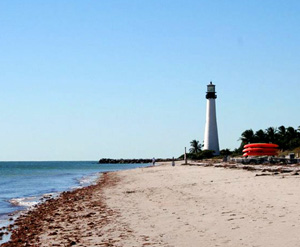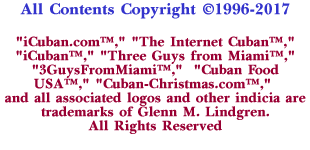Island-loving Cubans naturally love sand and surf. In fact, a typical vacation for Miami residents is to rent a place at the beach for a week or two, even when home is less than an hour away. Although it might seem strange to visitors from more northerly climes, going to the beach for Cubans is strictly a summertime phenomenon. No matter how hot it might get, Cubans will not go to the beach in the winter; that is for the tourists!
Although many love hotel-lined Miami Beach, or favor northern beaches such as Surfside and Haulover, the best places for a quick getaway are the small, pine-lined strips along the Rickenbacker Causeway just south of downtown. Affectionately called "Los Pinitos," these areas offer easy parking just steps away from the beach. Miamians love the relaxed atmosphere, where the family dog can share the surf with the wife and kids.

The most popular beaches for a traditional, all-day Cuban family picnic are the Cape Florida Light House beach ("El Farito") at the end of glittering Key Biscayne and Crandon Park at the entrance to the same island.
Beginning in the 1960s, El Farito was the spot for Cuban picnics. The area featured a wonderful sandy beach with shallow water where the children could frolic with reasonable safety.
A charming lighthouse towered over the beach. What attracted most Cubans was not the sunny beach, but an Australian pine forest that shaded the picnic area, providing a cool shelter for all the Cuban mothers and grandmothers who religiously avoided the merciless Miami sun.
A picnic at the beach involved days of preparation. There were dozens of phone calls among families and friends to coordinate who would bring what dish for the feast. This usually included several discussions (some heated) about who made the best black beans; a Cuban staple that everyone insists has never been made better than the rendition made by their own dear grandmother.
On the day of the picnic, family members young and old creep from their beds in the pre-dawn darkness. A cafecito for energy and it is time to load the cars. Fill the coolers with iced-down beer and Cuban sodas: Jupiña, Materva, and Coco Rico. Stuff grocery bags with snacks: five or six loaves of Cuban bread, boxes of Cuban pastries, and bags of plantain chips. Pack containers of tropical fruit cocktails loaded with mango, pineapple, papaya, grapes, melon, and apple thrown in for good measure in the coolers. The provisions also include a few bottles of rum to take the chill out of that first dive into the surf.
The goal of all Cuban families is to arrive at the gate at dawn and secure the choicest spot under the pines, but close enough to the beach to keep an eye on the kids, and not just small children, but teenagers; especially daughters with boyfriends!
Every Cuban picnic includes a big pot of moros y cristianos (black beans and rice) placed on the grill on arrival to cook to perfection in time for the late afternoon meal. This main meal might include anything from a small lechón (pork roast) to a whole pig slowly roasted and eaten for dinner at the end of the day. The eating, however, begins way before the pig is done. Thick hamburgers, Spanish-style chorizo, and American hot dogs crowd the grill and the beach goers eat them as appetizers all day long. The picnickers also make do with thin slices of Serrano ham, Manchego cheese, green olives, pickles, and Cuban crackers that serve as in-between snacks while the meats are grilling.
Even though this is a one-day event, the station wagons, trucks, and cars arrive with enough furniture to outfit a small house. There are lawn chairs, rocking chairs, a few taburetes, traditional Cuban chairs, and always a domino table. There are baby playpens and a crib or two. There are blankets, towels, napkins, and tablecloths. There are plates and bowls and assorted beach silverware. There are always a few portable radios, because after a few rum chasers, you know there will be dancing. There are footballs, beach balls, volleyballs, stuffed animals, buckets, and shovels. There are several umbrellas to keep the "killer sun" at bay even here under the pines.
Among the bathing-suited throng, the oldest participants are dressed not for a beach outing, but for a day at home. Grandmothers in particular are wearing long dark dresses and granddad might be wearing long pants and a short-sleeved guayabera. The older set never wears a bathing suit and never ventures much past the pines. Instead, they spend the day playing dominoes, cooking the day's meal, and minding the small children.
Everyone eats dinner in the early evening. Many stay on the beach until sunset, when everyone still standing helps pack the mass of picnic paraphernalia in the trunk. Sleeping kids are placed in the back seats of cars for the long ride home.
Although El Farito is still popular, Hurricane Andrew blew away the Australian pine forest in 1992. Now the beach is dotted with palms, not pines, and people are just as likely to eat at the good Cuban restaurant at the foot of the lighthouse. For a true Cuban cookout, purists go to the beach at Crandon Park where the shade of the pine trees still shelters the picnic area and children still frolic in the summer sun.

This new Kindle version contains all of the recipes and editorial copy from the original print edition. As a bonus, the new Kindle edition includes more than 24 new photos of the prepared dishes.
MORE THAN 30,000 PRINT COPIES SOLD
Drinks | Appetizers | Salads | Main Dishes
Soups | Side Dishes | Desserts | Index
Cuban, Spanish, and Latin American food recipes, Miami/Little Havana Travel Guide, Miami Restaurant Guide, Hispanic Culture & Food
